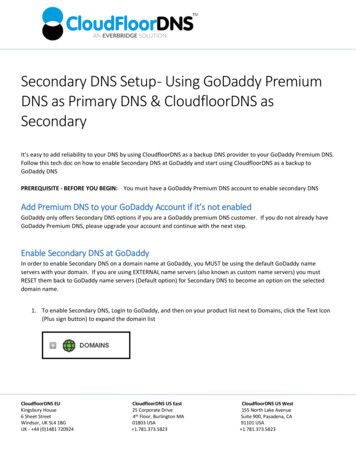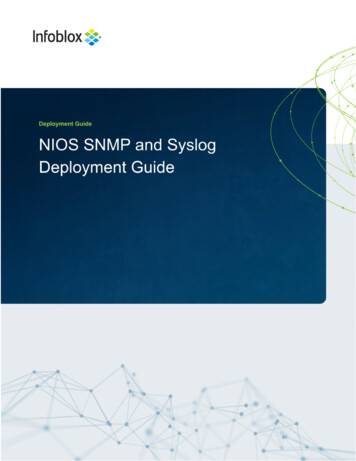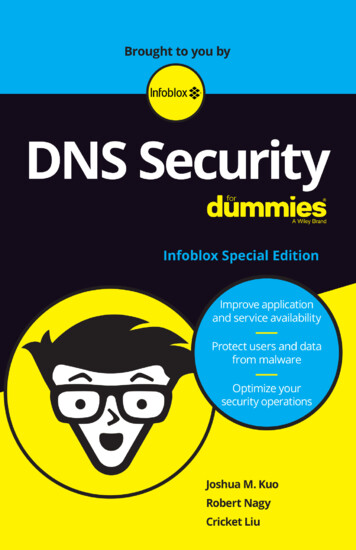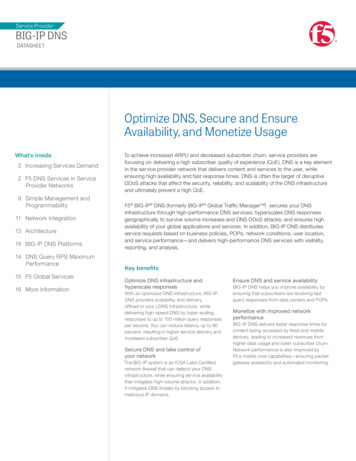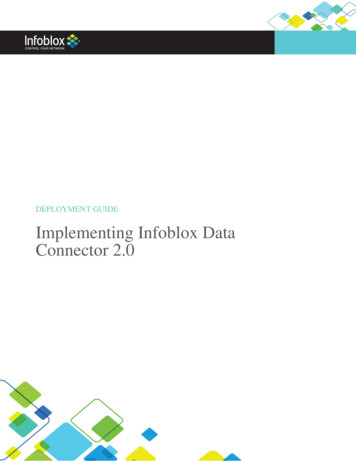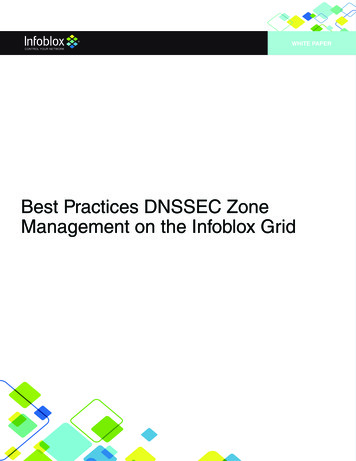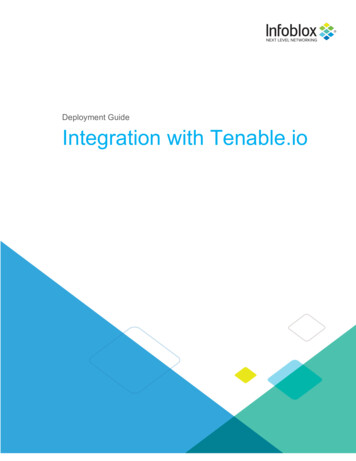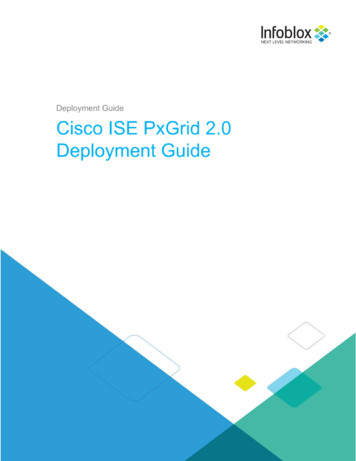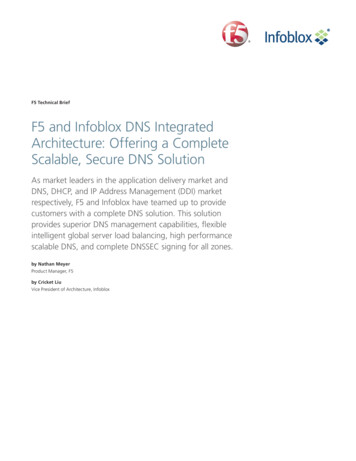
Transcription
F5 Technical BriefF5 and Infoblox DNS IntegratedArchitecture: Offering a CompleteScalable, Secure DNS SolutionAs market leaders in the application delivery market andDNS, DHCP, and IP Address Management (DDI) marketrespectively, F5 and Infoblox have teamed up to providecustomers with a complete DNS solution. This solutionprovides superior DNS management capabilities, flexibleintelligent global server load balancing, high performancescalable DNS, and complete DNSSEC signing for all zones.by Nathan MeyerProduct Manager, F5by Cricket LiuVice President of Architecture, Infoblox
Technical BriefF5 and Infoblox DNS Integrated Architecture: Offering a Complete Scalable, Secure DNS SolutionContentsPrerequisite Knowledge3Technology4Introduction5Overview of DNS Security Extensions5Real-time DNSSEC6Configuring Real-time DNSSEC8Configuring Infoblox DNSSEC8Overview of F5 and Infoblox Architectures9Delegation9Shortcut Around Using CNAME Aliases10DNSSEC Configuration in Delegation Architecture11Delegation Summary11Authoritative Screening11DNSSEC Options for Authoritative Screening14Advanced IP Anycast Configuration15Authoritative Screening Summary15Authoritative Slave16DNSSEC Options for Authoritative Slave16Authoritative Slave Summary17Choosing an Architecture17Conclusion18Learn More182
Technical BriefF5 and Infoblox DNS Integrated Architecture: Offering a Complete Scalable, Secure DNS SolutionPrerequisite KnowledgeThis document assumes the reader already has general familiarity with standardDNS architectures as well as a basic understanding of the workings of DNSSEC andhow DNSSEC is normally deployed. Additionally, this document assumes a generalunderstanding of global server load balancing techniques, functions, and features.There are many resources available to learn about DNS and DNSSEC. The Infobloxand F5 websites respectively contain more information regarding the features,implementation, and detailed configuration of the products.This tech guide provides high-level architecture covering three possible architecturesfor integrating F5 and Infoblox appliances. Additionally, this document providesfunctional information regarding real-time DNSSEC to give a better grasp ofthe various architecture implementations. There are many ways to architect anorganization’s DNS system and many configuration tricks. This document is notmeant to be an exhaustive study of all the possible ways to architect an integratedDNS solution, but rather to illustrate the most useful and common architectures.Readers of this document will be able to gain insight into what comprises anF5 and Infoblox integrated architecture, and begin planning for a BIG-IP GTMand Infoblox DNS deployment. Please refer to the respective manuals for theF5 BIG-IP GTM and Infoblox appliances on each organization’s website for detailedconfiguration information.3
Technical BriefF5 and Infoblox DNS Integrated Architecture: Offering a Complete Scalable, Secure DNS SolutionTerminologySeveral abbreviations, general DNS, and product specific terms are used throughoutthis document.Local domain name server (LDNS ) – A client recursive DNS server. Most DNSqueries originate from an LDNS server rather than a client.Fully qualified domain name (FQDN) – This refers to a complete DNS name thatincludes both the host and domain (for example, www.example.com).Global server load balancing (GSLB) – A generic term referring to a collection ofintelligent DNS techniques and methods used to provide the best possible IP addressanswer for a given record query.BIG-IP Global Traffic ManagerTM (GTM) – An F5 product used to provide GSLBservices. BIG-IP GTM manages traffic between application clients and data centers.F5 BIG-IP Local Traffic Manager (LTM) – An F5 product used to provide loadbalancing and application delivery services for a particular web service or otherapplication. BIG-IP LTM manages traffic in a data center or a group of servers.Wide IP address (WIP) – An F5 product term for a fully qualified domain namerepresenting a resource managed by BIG-IP GTM (for example, www.example.comor www.gtm.example.com).Key signing key (KSK) – This is used to sign other keys including ZSKs.Zone signing key (ZSK) – This is used to sign the zone’s signature records.Start of authority (SOA) – This specifies authoritative information about a DNS zone,including the primary name server, the email address of the zone’s administrator,the zone’s serial number, and several timers relating to refreshing the zone.Canonical name record (CNAME) – A type of resource record in the DomainName System (DNS) that specifies that the domain name is an alias of another,canonical domain name.Address record (A-record) – Returns a 32-bit IPv4 address, most commonly usedto map host names to a host IP address.Mail exchanger record (MX record) – Maps a domain name to a list ofmessage transfer agents for that domain; usually returns an A-record (for example,mail.example.com).4
Technical BriefF5 and Infoblox DNS Integrated Architecture: Offering a Complete Scalable, Secure DNS SolutionIntroductionMany organizations are looking for a complete DNS solution that will enable thebest-of-breed features in DNS management, intelligent global server load balancing,performance, and security. Traditionally, there has been a gap between the easymanagement features offered by DNS appliance vendors and application deliveryvendors focused on global server load balancing. This gap is evident in the newrequirements needed to provide DNSSEC features that guarantee the authenticityof DNS responses, enabling a much more secure Internet environment. No singlevendor is able to offer a complete solution. As market leaders in the applicationdelivery market and DNS, DHCP, and IP Address Management (DDI) marketrespectively, F5 and Infoblox have teamed up to provide customers with acomplete solution. This solution provides superior DNS management capabilities,flexible intelligent global server load balancing, high performance scalable DNS,and complete DNSSEC signing for all zones.“The lack of DNS security not onlymakes the Internet vulnerable, butis also crippling the scalability ofimportant security technologies.DNSSEC offers the most feasiblesolution to a serious threat.”Dan Kaminsky, Director ofPenetration Testing, IOActiveOverview of DNS SecurityExtensionsMany security experts, including Dan Kaminsky, Director of Penetration Testingat IOActive, consider DNS Security Extensions (DNSSEC) to be an essential toolin “sealing” DNS vulnerabilities and mitigating DNS cache poisoning attacks thatundermine the integrity of the DNS system. DNS attackers are able to directusers to alternate sites enabling collection of credit cards and passwords, redirecte-mail, and compromise any other Internet application that is dependent on DNS.DNSSEC implements an automated trust infrastructure enabling systems to verifythe authenticity of DNS information.Unfortunately, DNSSEC adoption has been hampered by concerns over theoperational complexity of provisioning encryption keys and the processing overheadrequired to sign DNS information. Prior to F5’s innovative real-time signing capability,there were no options to secure the DNS responses from a global server loadbalancing system (GSLB). Organizations had to choose between deploying highlyavailable intelligent DNS systems or securing their DNS infrastructure with DNSSEC.The combined F5 and Infoblox solution addresses these issues with complementarysolutions, bringing to market a fully integrated and complete DNSSEC solutionincluding high performance DNS and GSLB functions, all supporting, signed DNSSEC5
Technical BriefF5 and Infoblox DNS Integrated Architecture: Offering a Complete Scalable, Secure DNS Solutiondata. This provides customers a scalable, manageable, and secure DNS infrastructurethat is equipped to withstand DNS attacks.The solution is a combination of Infoblox purpose-built appliances that deliver highlyreliable, manageable, and secure DNS services, with built-in, automated DNSSECfeatures, and F5 BIG-IP Global Traffic Manager (GTM) appliances optimizedto facilitate real-time signing of DNS responses. Infoblox’s DNSSEC featuresreplace manual key generation and zone signing with a “one-click” process thatautomatically generates encryption keys, signs zone data, and distributes signeddata to all Infoblox appliances that serve DNS data. F5 provides a Federal InformationProcessing Standard - (FIPS) compliant option to satisfy FIPS 140-2 requirements.Both F5 and Infoblox systems handle the National Institute of Standards andTechnology (NIST) recommended key polices that are outlined in NIST SpecialPublication 800-81 Secure DNS Deployment Guide.Real-time DNSSECF5’s implementation of DNSSEC through patent-pending, real-time signing is acrucial architectural element in the F5 and Infoblox joint three architecture solutions.Standard implementations of DNSSEC assume a fairly static zone configuration thatprovides the same responses to a specific DNS query, whether an SOA, MX, orA-record. Changes to a zone’s records are generally minimal. The zones are usuallypre-signed with all the appropriate keys and hashing and stored in the same staticzone files. Signing a large zone can take longer than thirty minutes dependingon the size of the zone. Infoblox supports incremental signing that reduces theoverhead associated with record information changes. Infoblox also providesmarket-leading, single-step DNSSEC signing and automated key management,making it easier to provide DNSSEC responses for a standard DNS zone.The basic premise of global server load balancing (GSLB) is to provide the bestanswer for a particular resource based on information obtained from the requestingLDNS’s IP address. There are many options and modes for deploying GSLB,including round trip time calculations, IP geolocation, dynamic server load, ratios,and resource monitoring. Since each LDNS server can receive a different answerfor a given A-record request it is possible for the same LDNS server to receivedifferent answers at different times. In general, GSLB services are incompatiblewith traditional DNSSEC implementations. DNSSEC specs were not designed withconsideration of GSLB.The F5 BIG-IP system of products operates on a universal, shared product platform6
Technical BriefF5 and Infoblox DNS Integrated Architecture: Offering a Complete Scalable, Secure DNS Solutioncalled TMOS . TMOS intercepts the DNS request as it enters the system andremembers if the request was a normal DNS request or a DNSSEC request. TMOSthen sends the request to the BIG-IP Global Traffic Manager (GTM) module forresolution. Assuming the request is the appropriate type, BIG-IP GTM processesthe request, taking into account all the business rules, monitoring, and globalload balancing features. BIG-IP GTM then passes the request back to TMOS. Ifthe original request is for DNSSEC, TMOS signs the resource record set in realtime using high-speed cryptographic hardware and sends the response back tothe LDNS server. This method also works well with standard DNS queries that arepassed through to an Infoblox appliance. The cryptographic hardware and a specialsignature RAM cache of signatures enable TMOS to sign most queries in realtime, at high speed. However, for extremely large static zones containing no GSLBelements, using the traditional DNSSEC pre-signed method offers performanceand resource utilization advantages. TMOS’s intelligent architecture enables aDNS response that has already been signed to pass through, allowing for hybridDNSSEC deployments specific to each zone. Normally, private keys are stored ina triple-encrypted key storage called the secure vault. Customers that requiremilitary-grade security can use hardware FIPS cards found on different F5 devices forprivate key generation and storage. These FIPS cards share the same configurationand can synchronize FIPS keys, maintaining full FIPS compliance even while beinggeographically separated.7
Technical BriefF5 and Infoblox DNS Integrated Architecture: Offering a Complete Scalable, Secure DNS SolutionConfiguring Real-time DNSSECIt is a simple, three-step process to configure real-time DNSSEC signing:1. Create a key signing key2. Create a zone signing key3. Assign those keys to the appropriate BIG-IP GTM-controlled subzonesThe final, manual step is to export the public KSK and register it with the next-,higher-level zone authorityConfiguring Infoblox DNSSECInfoblox appliances support full, standard DNSSEC features. Infoblox has developedvery intuitive tools. Default settings can be configured at the global grid level. TheInfoblox management tools enable an easy, one-click DNSSEC upgrade of any zoneto start providing DNSSEC responses. The final, manual step is to export the publicKSK and register it with the next, higher-level zone authority or independent trustanchor.8
Technical BriefF5 and Infoblox DNS Integrated Architecture: Offering a Complete Scalable, Secure DNS SolutionOverview of F5 and InfobloxArchitecturesThere are several important points to consider when deploying a combinedarchitecture: Authoritative systems Configuration hosting Zone updates Load balancing Infoblox appliances Service divisions between GSLB records and static zone records System aliasing using CNAME records Zone size and records typesThe three architectures discussed in this document include:1. Delegation2. Authoritative Screening3. Authoritative SlaveDelegation is the most common, simplest, and involves delegating a specific subzone that contains all the GSLB elements of the DNS architecture. In this scenario, aCNAME is used to redirect other names to one located in the delegated sub-zone.Authoritative Screening is more sophisticated and offers a highly integrated solution.It also offers greater scalability and protection of the Infoblox architecture. Usingan Authoritative Slave architecture, DNS requests are processed on the BIG-IP GTMsystem, while the Infoblox appliance serves as the hidden primary for the zone. Inaddition to describing the general DNS architecture in this paper, there is a sectionfor each architecture that discusses DNSSEC-specific options and deployment.DelegationThe Delegation solution is recommended for organizations seeking a simpleconfiguration with clear assignments of zones for standard DNS and GSLB services.In this example, the Infoblox appliance completely manages the top-level zone,example.com. The NS records point to the names and, indirectly, the IP address9
Technical BriefF5 and Infoblox DNS Integrated Architecture: Offering a Complete Scalable, Secure DNS Solutionof the Infoblox appliances. BIG-IP GTM is authoritative for a subzone and handlesall queries to that zone (for instance, gtm.example.com). All GSLB resources arerepresented by A-records in the GTM zone. A BIND name server running on BIG-IPGTM contains the subzone records. Host names in the top-level zone are referred tothe GTM-controlled subzone using CNAME alias records. CNAME references can befrom almost any other zone, including the subzone. More than one subzone can bedelegated to and managed by GTM xample.comCNAMEmail.gtm.example.comShortcut Around Using CNAME AliasesFor high-profile, high-volume names (such as www.example.com), the use of aCNAME could cause an extra redirect and lookup, providing undesirable latency.A shortcut can be employed by creating and delegating a subzone to the BIG-IPGTM device. This shortcut only works for a single name in each subzone; however,any number of zones can be delegated in the same manner. The subzone shortcutremoves the need for a CNAME redirect while still using a Delegation architecture.In this example, a subzone called www.example.com is created and delegated tothe BIG-IP GTM device. The zone configuration on BIG-IP GTM includes the normal10
Technical BriefF5 and Infoblox DNS Integrated Architecture: Offering a Complete Scalable, Secure DNS SolutionNS records, as will the higher-level example.com zone, but the zone will onlycontain one host record. The BIG-IP GTM WIP is configured to match that ofwww.example.com and always provides GSLB services for www.example.com.DNSSEC Configuration in Delegation ArchitectureThe DNSSEC configuration is very simple when using a delegated zone architecture.Top-level, standard DNS zones (such as example.com) are managed and signedby the Infoblox appliance. All other standard DNS zones or subzones managed byInfoblox are signed similarly. All standard DNS queries in zones managed by Infobloxcan respond with DNSSEC responses. All GSLB queries which are sent to the GTMsubzone are signed in real-time by TMOS after BIG-IP GTM decides which answer isthe best for each specific client.“The combination of F5’s and Infoblox’sappliances provide enterprisecustomers an opportunity to buildauthoritative DNS infrastructure withoutgiving up either global server loadbalancing or DNSSEC—that’s a clearvalue-add to performance and security.”Cricket Liu, Vice President of Architecture,InfobloxDelegation SummaryThe Delegation architecture is easy to implement for DNS and DNSSEC responses.The downside is that the Delegation architecture also requires maintaining thesubzone configuration on the BIG-IP GTM device itself. Some organizations find thatusing CNAME records is difficult to manage on a larger scale. Other organizationsare sensitive to latency and, therefore, would prefer not to use CNAME records atall. The subzone shortcut provides a solution to avoid CNAME records but doesnot scale as a general purpose solution. The Delegation architecture is a better fitfor organizations with a smaller number of zones and resources using the GSLBfeatures, and with lower overall DNS performance requirements.Authoritative ScreeningAuthoritative Screening is the most powerful, flexible, and integrated of the threesolutions. Deploying the Authoritative Screening architecture running version 10.1of BIG-IP GTM requires licensing both a BIG-IP Local Traffic Manager andBIG-IP GTM. BIG-IP GTM running version 10.2.0 will enable this configuration towork correctly with only BIG-IP GTM licensed. With version 10.2 the standaloneBIG-IP GTM will also be able to use this architecture.The Authoritative Screening architecture enables BIG-IP GTM to receive all DNSqueries, managing very high-volume DNS by load balancing requests to a pool ofInfoblox appliances. In addition, the Authoritative Screening architecture seamlessly11
Technical BriefF5 and Infoblox DNS Integrated Architecture: Offering a Complete Scalable, Secure DNS Solutionprovides all of the benefits of intelligent GSLB services. The BIG-IP GTM listenerIP address should be configured in an NS record authoritative for the zone, not asa delegated subzone. When a DNS query is received, TMOS will check the recordtype. If the type is an A, AAAA, A6, or CNAME request, it will be sent to BIG-IPGTM. BIG-IP GTM will check each request and response, looking for a match againstthe wide IP (WIP) list of FQDN names. If there is a match, BIG-IP GTM will performthe appropriate GSLB functions and return the best IP address appropriate for therequesting client.If the DNS request does not match the WIP list, BIG-IP GTM will pass the requestto a pool of Infoblox appliances. Load balancing requests to a pool of Infobloxappliances provides an additional layer of scalability and availability, increasing thequery performance and ensuring optimal uptime of DNS services.The BIG-IP GTM unit is configured with a standard DNS listener on port 53 for bothTCP and UDP, and uses the external IP address referenced in the SOA-record forns1.example.com. In the virtual server configuration, create a pool that containsseveral Infoblox appliances, each with their own separate IP address. The Infobloxappliance can be fully authoritative for the zones for internal clients. However, allexternal NS records for the top-level zone (such as example.com) should point onlyto the external IP address allocated to the F5 BIG-IP device.12
Technical BriefF5 and Infoblox DNS Integrated Architecture: Offering a Complete Scalable, Secure DNS SolutionA good illustration of the integrated capability of a BIG-IP GTM screeningarchitectures is when an MX record is requested. BIG-IP GTM only has the WIP listand configuration for processing the WIP queries. All zone records are maintainedon the Infoblox appliances. The requests flow through the system in the followingsteps:1. T MOS receives the MX query for example.com. TMOS first checks the recordtype. Only A, AAAA, A6, or CNAME requests are sent to BIG-IP GTM. Allother record types are immediately sent to DNS. Because the request in thisexample is for an MX record, TMOS sends the query directly to the Infobloxappliances using the configured ratio load balancing method.2. T he Infoblox appliance responds, indicating that the MX record for example.com resolves to A-record mail.example.com.3. TMOS sends the request to BIG-IP GTM to check if there is a match for a WIP.4. B IG-IP GTM detects a match in the WIP list for mail.example.com andprocesses the query according to the configuration for mail.example.com.In this case, BIG-IP GTM uses IP geolocation to find the closest mail server forthe client and responds with the best IP address.5. T MOS responds to the original MX record request—mail.example.com—andrewrites the A-record answer with the IP address that has been globally loadbalanced by BIG-IP GTM.6. I f DNSSEC was originally requested, the response will be signed in TMOSbefore it’s sent to the requesting LDNS.13
Technical BriefF5 and Infoblox DNS Integrated Architecture: Offering a Complete Scalable, Secure DNS SolutionAn illustration of the request flow when the initial record type is an A-record.1. T he initial query is for ftp.example.com. TMOS first checks the record typeand since it is an A-record, passes the request to BIG-IP GTM to see if it is amatch against the WIP list.2. I f ftp.example.com is a match for a WIP, BIG-IP GTM handles the processingand sends the response back to TMOS. In this case, ftp.example.com is not amatch, so the request is sent to DNS.3. T he request is load balanced and processed by the Infoblox appliance inexactly the same way as the MX record illustration.4. W hen the CNAME response is returned from Infoblox containing an A-record,server.example.com, TMOS sends the response to BIG-IP GTM to check ifserver.example.com is a match for a WIP.5. B IG-IP GTM then matches server.example.com as a WIP, processes therequest, and sends the response back to TMOS.DNSSEC Options for Authoritative ScreeningIt is possible for TMOS to do the DNSSEC signing in real-time and on demand, for allzones. Any zone containing dynamic GSLB names in the BIG-IP GTM configurationmust be signed by TMOS, in real time.14
Technical BriefF5 and Infoblox DNS Integrated Architecture: Offering a Complete Scalable, Secure DNS SolutionIf there are standard DNS zones that do not contain any BIG-IP GTM-configuredWIP names, it is possible to use the native Infoblox DNSSEC capabilities to signthose zones. In this hybrid configuration, BIG-IP GTM will detect a DNSSEC signedresponse and pass it through to the requesting LDNS server without modification orre-signing. This hybrid configuration requires different KSKs and ZSKs for Infobloxsigned zones.Advanced IP Anycast ConfigurationWith this architecture several F5 devices can be deployed at different locationsaround the world using the same external IP address. The technique is oftenreferred to as IP Anycast. F5 calls this feature route health injection (RHI). EachF5 device advertises the same IP address(es) to the next hop routers. The routingsystem routes requests from LDNS servers to the closest BIG-IP GTM system.Using IP Anycast and the routing system to geographically distribute DNS queriescan decrease DNS latency and provide some level of DNS denial of service(DoS) protection.Authoritative Screening SummaryThe screening architecture enables intelligent DNS and global server load balancingtechniques for any record type that resolves to an A-record. This architecture offersthe best of all worlds, with the ability to support and manage all DNS records onthe Infoblox appliance while simultaneously providing load balancing and intelligentDNS functions for any particular service or site. This architecture avoids adesignated zone for load balanced names and eliminates the use of CNAMEredirects. BIG-IP GTM screens the DNS traffic sent to the Infoblox appliances andonly intercepts the requests and responses when they match a name designatedin the BIG-IP GTM configuration. BIG-IP GTM only manages the GSLB-specific WIPconfiguration information. The Infoblox appliance maintains and manages all zonerecords. There are several ways to implement DNSSEC. One easy method wouldbe to use real-time DNSSEC signing for all zones. Alternatively, an organizationcould choose to deploy a hybrid configuration with some zones being signed andmanaged by the Infoblox appliance. IP Anycast techniques can be implementedfor advanced architectures providing better performance and DNS DoS protection.Other than being more complex to setup, the authoritative screening architectureprovides many advantages with very few caveats.15
Technical BriefF5 and Infoblox DNS Integrated Architecture: Offering a Complete Scalable, Secure DNS SolutionAuthoritative SlaveThe Authoritative Slave architecture is very similar to the Authoritative Screeningarchitecture. Both architectures deploy BIG-IP GTM as the external authoritativename server. The major difference is that all DNS requests are handled byBIG‑IP GTM and not load balanced or passed to any Infoblox appliances. There isa standard BIND name server running on the BIG-IP GTM that attempts to answerany query not handled by BIG-IP GTM module or load balanced to an externalname server. In this architecture, the local BIND name server answers all standardDNS queries and acts as a slave to the Infoblox primary master server. Thezone configuration is copied to the BIG-IP GTM BIND name server via standardzone transfers. The same WIP-matching occurs like in the Authoritative Screeningarchitecture; however, any non-matching names are simply handled by the localBIND name server instead of being passed to an Infoblox appliance.DNSSEC Options for Authoritative SlaveTMOS can handle all DNSSEC signing in real-time, on demand as clients requestDNSSEC authenticated responses. The setup process is exactly the same as describedin the real-time DNSSEC Configuration section. Any zone that includes GSLB WIPnames requires TMOS to perform the DNSSEC signing in real time.16
Technical BriefF5 and Infoblox DNS Integrated Architecture: Offering a Complete Scalable, Secure DNS SolutionIf there are standard DNS zones that contain no WIP names configured in BIG-IPGTM, then it is possible to use the native Infoblox DNSSEC capabilities to sign thosezones. In this hybrid configuration, the Infoblox pre-signed DNSSEC zones will bezone-transferred to the BIG-IP GTM and used like a normal zone file. TMOS willdetect a DNSSEC signed response and pass it through to the requesting LDNS serverwithout modification and without re-signing. This hybrid configuration requireshaving different key signing keys and zone signing keys for the zones signed byInfoblox.Authoritative Slave SummaryThe Authoritative Slave architecture is very similar to the Authoritative Screeningarchitecture. In addition, it uses intelligent DNS and GSLB techniques for any recordtype that resolves to an A-record. This solution offers some of the benefits of thescreening solution. The same DNSSEC techniques apply, including a pure, real-timeDNSSEC configuration or a hybrid configuration with some zones being signed andmanaged by the Infoblox appliance. Since the slave configuration does not spreadthe DNS queries across several high performance Infoblox appliances, it does notprovide high performance responses for standard BIND records. This solution is idealwhen the majority of DNS queries are for GSLB resources and BIND is only neededto handle the other records types and a small percentage of standard DNS queries.Choosing an ArchitectureUltimately, each organization’s unique requirements, existing infrastructure, trafficpatterns, applications, growth plans, and politics will determine which architectureoffers the best starting point. There are many variations possible based on thesearchitectures: rganizations that are new to GSLB and have a complex Infoblox DNSOarchitecture with the capacity to handle the DNS request volume should startwith a Delegation architecture. This is a minimally disruptive way to start usingintelligent GSLB services. elegation is often the only option when internal politics or policies precludeDthe ability to change any part of the existing Authoritative architecture. L arger organizations with higher volumes of DNS requests, concerns aboutDNS DoS attacks, a need to deploy DNSSEC, and a desire to avoid usingCNAMEs and subzones will likely find the Authoritative Screening architecturea better fit for their requirements.17
Technical BriefF5 and Infoblox DNS Integrated Architecture: Offering a Complete Scalable, Secure DNS Solution S maller organizations with fewer zones and records, relatively lowperformance requirements, and GSLB requirements should consider theAuthoritative Slave architecture, using an Infoblox appliance to consolidateand provide superior management.ConclusionEach joint F5 and Infoblox solution provides unique advantages and functionsthat enable any organization to meet their requirements. Published DNSvulnerabilities and news of high profile DNS attacks indicate the traditional DNSsystem needs to adapt, becoming more scalable, available, secure, and trusted.While DNSSEC can solve at least some of the problems, it ca
Configuring Infoblox DNSSEC Infoblox appliances support full, standard DNSSEC features. Infoblox has developed very intuitive tools. Default settings can be configured at the global grid level. The Infoblox management tools enable an easy, one-click DNSSEC upgrade of any zone to start providing DNSSEC responses.
